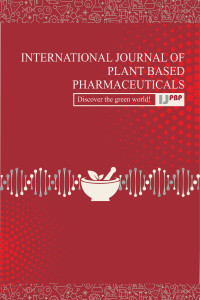Phenolic compounds of natural knotweed (Polygonum cognatum Meissn.) populations from Turkey
Phenolic compounds of natural knotweed (Polygonum cognatum Meissn.) populations from Turkey
The phenolic compositions of two different Polygonum cognatum samples collected from the Cumra and Manisa regions of Turkey were investigated for the first time. Both tested samples were rich in different phenolic compounds, mostly rutin, isorhamnetin, and catechin. The rutin content of Cumra’s sample was relatively higher than that of Manisa’s sample. P. cognatum has potential regarding rutin content as a functional dietary food or may be used as an ingredient to enrich functional foods. Our study will contribute to the previous works performed by different researchers on P. cognatum, commonly consumed in Turkey, to reveal its beneficial properties.
Keywords:
Knotweed, Phenolic compounds, Polygonum cognatum, Turkey,
___
- Atanassova, M., Bagdassarian, V., 2009. Rutin content in plant products. Journal of the University of Chemical Technology and Metallurgy, 44(2), 201-203.
- Baytop, T., 1999. Therapy with Medicinal Plants in Turkey Past and Present. Nobel Tip Kitab Evleri, Istanbul, p. 480.
- Bondonno, C. P., Bondonno, N. P., Shinde, S., Shafaei, A., Boyce, M.C., Swinny, E., Hodgson, J.M., 2020. Phenolic composition of 91 Australian apple varieties: towards understanding their health attributes. Food & Function, 11(8), 7115-7125.
- Chu, X., Sun, A., Liu, R., 2005. Preparative isolation and purification of five compounds from the Chinese medicinal herb Polygonum cuspidatum Sieb. et Zucc by high-speed counter-current chromatography. Journal of Chromatography A, 1097(1-2), 33-39.
- Davis, P.H., 1967. Flora of Turkey and the East Aegean Islands. Edinburg University Press.
- Dinc, S., Kara, M., Karipcin, M.Z., Sari, N., Can, Z., Cicekci, H., Akkus, M., 2018. The rootstock effects on agronomic and biochemical quality properties of melon under water stress. FEB-Fresenius Environmental Bulletin, 27(7) 5008-5021.
- Dereli, F.T.G., Ilhan, M., Kozan, E., Akkol, E.K., 2019. Effective eradication of pinworms (Syphacia obvelata and Aspiculuris tetraptera) with Polygonum cognatum Meissn. Experimental Parasitology, 196, 63-67.
- Jansone, B., 2015. Assessment report on Polygonum aviculare L. herba. Committee on Herbal Medicinal Products (HMPC), 33 pp.
- Jiang, P., Burczynski, F., Campbell, C., Pierce, G., Austria, J.A., Briggs, C.J., 2007. Rutin and flavonoid contents in three buckwheat species Fagopyrum esculentum, F. tataricum, and F. homotropicum and their protective effects against lipid peroxidation. Food Research International, 40(3), 356-364.
- Kandakumar, S., Manju, D.V., 2017. Pharmacological applications of isorhamnetin: A short review. International Journal of Trend in Scientific Research and Development, 1, 672-678.
- Kara, M., Dinc, S., Kahraman, S., Karipcin, M.Z., Alp, I., Cicekci, H., 2015. Ground Urfa isot peppers with high content of bioactive compounds and antioxidant activity. Zeitschrift für Arznel-und Gewürzpflanzen, 20(4), 158-164.
- Kiokias, S., Proestos, C., Oreopoulou, V., 2020. Phenolic acids of plant origin—A review on their antioxidant activity in vitro (o/w emulsion systems) along with their in vivo health biochemical properties. Foods, 9(4), 534.
- Kreft, I., Fabjan, N., Yasumoto, K., 2006. Rutin content in buckwheat (Fagopyrum esculentum Moench) food materials and products. Food Chemistry, 98(3), 508-512.
- Kuo, C.H., Chen, B.Y., Liu, Y.C., Chang, C.M.J., Deng, T.S., Chen, J.H., Shieh, C.J., 2014. Optimized ultrasound-assisted extraction of phenolic compounds from Polygonum cuspidatum. Molecules, 19(1), 67-77.
- Lorenzo, J.M., Munekata, P.E.S., 2016. Phenolic compounds of green tea: Health benefits and technological application in food. Asian Pacific Journal of Tropical Biomedicine, 6(8), 709-719.
- Macar, O., Kalefetoglu, T., 2018. Altitude Triggers Some Biochemical Adaptations of Polygonum cognatum Meissn. Plants. Cumhuriyet Science Journal, 39(3), 621-627.
- Önen, H., Altuntaş, E., Özgöz, E., Bayram, M., Özcan, S., 2014. Moisture effect on physical properties of knotweed (Polygonum cognatum Meissn.) seeds. Journal of Agricultural Faculty of Gaziosmanpaşa University, 31(2), 15-24.
- Önen, H., Yılar, M., Kaya, C., 2009. Phenolic composition of madimak (Polygonum cognatum Meissn.) Plants, 3rd Plant Protection Congress, Van, Turkey, Abstract Book page 275.
- Polat, R., 2019. Ethnobotanical study on medicinal plants in Bingöl (City center)(Turkey). Journal of Herbal Medicine, 16, 100211.
- Sargin, S.A., Selvi, S., López, V., 2015. Ethnomedicinal plants of Sarigöl district (Manisa), Turkey. Journal of Ethnopharmacology, 171, 64-84.
- Ulusoy, H.İ., Acıdereli, H., Tutar, U., 2017. Optimization of extraction parameters for fat soluble vitamins and major element analysis in Polygonum cognatum Meissn plant (Madimak). Journal of the Turkish Chemical Society Section A: Chemistry, 4(1), 165-178.
- Ulusoy, S., Erdoğan, S., Karaslan, M.G., Ates, B., Ulusoy, H.İ., Erdemoğlu, S., 2018. Optimization Of Extraction Parameters For Folic Acid And Antioxidant Compounds From An Edible Plant (Polygonum cognatum Meissn) Using Pressurized Liquid Extraction (PLE) System. Cumhuriyet Science Journal, 39(4), 1069-1080.
- Wang, D.G., Liu, W.Y., Chen, G.T., 2013. A simple method for the isolation and purification of resveratrol from Polygonum cuspidatum. Journal of Pharmaceutical Analysis, 3(4), 241-247.
- Yıldırım, A., Mavi, A., Kara, A.A., 2003. Antioxidant and antimicrobial activities of Polygonum cognatum Meissn extracts. Journal of the Science of Food and Agriculture, 83(1), 64-69.
- Başlangıç: 2021
- Yayıncı: Kilis 7 Aralık Üniversitesi
Sayıdaki Diğer Makaleler
Faika BAŞOĞLU, Selin TUFAN, Nur TAN
Mustafa KOÇER, Erman Salih İSTİFLİ
Firdose KOLAR, Vinuta NİRMANİK, Annapurna KAGAWAD, Laxmi ANGADİ, Babu LAMANİ
Anthocyanins: Plant-based flavonoid pigments with diverse biological activities
Sandip PATRA, Priyanka MAKHAL, Shubham JARYAL, Nilesh MORE, Venkata Rao KAKİ
Phenolic compounds of natural knotweed (Polygonum cognatum Meissn.) populations from Turkey
Ahmet GÜMÜŞÇÜ, Saliha DİNÇ, Meryem KARA, Mehmet AKKUŞ, Gönül GÜMÜŞÇÜ
Nassereldeen KABBASHİ, Tahani MAHER ALAWDAT, Isam Y. QUDSIEH, Md Zahangir ALAM, Munirah SHAHABUDDIN
Effects of systemic hydroxytyrosol application in experimental periodontitis of rats
